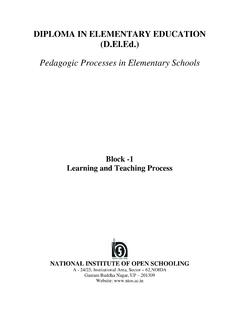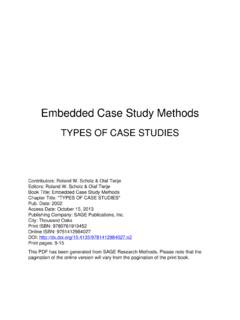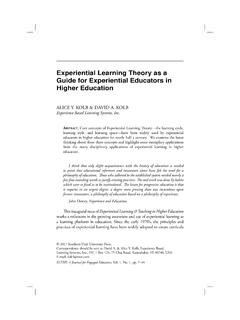Transcription of Concepts of Learner-Centred Teaching
1 ShanlaxInternational Journal of Educationshanlax#SINCE1990 of Learner-Centred TeachingRajendra Kumar ShahAssociate Professor, Tribhuvan University (Sanothimi Campus), Bhaktapur, Nepal article traces the historical development of learner-centered Teaching (LCT) and examines the major contributions of educators. Accordingly, this article has also analyzed the perception of various educationists regarding LCT. LCT is an approach to Teaching that is increasingly being encouraged in education. The paradigm shifts away from Teaching to importance on learning have boosted the power to be moved from the teacher to the student. The teacher focused/transmission of information formats, such as lecturing, have begun to be increasingly criticized, and this has paved the way for the widespread growth of LCT as an alternative approach.
2 Many terms have been linked with LCT, such as flexible learning, experiential learning, self-directed learning, and therefore the slightly overused term LCT can mean different things to different people. Also, in practice, it is described by a range of terms, and this has led to confusion surrounding its implementation. LCT has a long history of development. Two of the first educators to emphasize the learners were Confucius and Socrates (5th to 4th centuries ). Over two millennia passed before seventeenth-century Englishman Locke introduced experiential education (the idea that one learns for experience). Another two hundred years spent before European educators Pestalozzi, Herbart, and Froebel designed and popularized experience-based, learner-centered curricula.
3 In the school system, the concept of LCT has been derived, in particular, from the work of Froebel and the idea that the professor should not interfere with this process of maturation, but act as a guide. A century later, nineteenth-century educator Colonel Francis Parker brought this method to America. Twentieth-century Russian sociologist Lev Vygotsky, Swiss psychologist Jean Piaget, American philosopher and educator Dewey shaped the existing LCT into a program called : Learner-Centered Teaching (LCT), Teacher-Centered Teaching (TCT), Pedagogy, Teaching , Learning, Children, of Learner-Centred Teaching The traditional Teaching , which is distinguished by its expository form and narrative character, has been the most pervasive pedagogical model around the world.
4 Critique to this model has been developed at different historical moments, and socio-economic and geographical contexts, with different political aims in mind, by various actors such as critical pedagogues from developing countries ( , Freire), educationalists in the western world ( , Rousseau, Dewey, and Vygotsky) and international organizations involved in education ( , UNESCO and UNICEF). traditional Teaching has been criticized for relegating education to an act of depositing whereby teachers make deposits and students receive, memorize, and repeat to the best of their efforts and capacities (Freire 1996). Such practices have also been examined for being ineffective and leading to the acquisition of skills of a lower taxonomic level (Gauthier and Dembele 2004), for undermining spontaneity and initiative among students (O Sullivan 2004) and for inhibiting creativity and critical thinking (Freire 1996).
5 Early progressive movements proposing alternatives to traditional Teaching originated in the second half of the 1800s (Windschitl 2002). In the following period, several other dilemmas have been proposed, yet the current discussion is managed by two competing approaches. These are traditional Teaching approaches and learner-centered Teaching (LCT), constructivism. The former advocate s structure and some directivity in supporting the learning process effectively in school environments, and the second is contrasted with the traditional model (Gauthier and Dembele 2004).OPEN ACCESSM anuscript ID: EDU-2020-08032926 Volume: 8 Issue: 3 Month: JuneYear: 2020P-ISSN: 2320-2653E-ISSN: 2582-1334 Received: : : : Shah, Rajendra Kumar.
6 Concepts of Learner-Centred Teaching . Shanlax International Journal of Education, vol. 8, no. 3, 2020, pp. 45 : This work is licensed under a Creative Commons Attribution-ShareAlike International LicenseShanlaxInternational Journal of Education shanlax#SINCE1990 The LCT has been known by a variety of terms, including child-centered education; child-centered pedagogy; child-centered Teaching ; child-centered learning, learner-centered approach, student-centered Teaching , student-centered learning; learner-centredness; or student-centered. These terms have all been used interchangeably (Harmelen, 1998; Lall, 2010; O Neill & McMahon, 2005).
7 Chung and Walsh (2000) state that there have been more than 40 different meanings of the term in contemporary usage. Because these Concepts are applied across all spectrums/levels of education, learner-centered Teaching and student-centered Teaching tend to be the preferred terms for older learners , whereas child-centered might be used in early-childhood or primary school contexts. More people are talking about learner-centered Teaching (LCT) instead of child-centered Teaching (CCT). This is because the term LCT covers a wider range of learners . So far as LCT is concerned, it has been identified that education needs to go beyond a concern with only children but a concern for a wider range of learners .
8 Thus, the term LCT began to be used with more frequency in general education and is considered a more appropriate term to be applied to everyone in this learning society (Lambert and McCombs, 1997). The contemporary meanings of LCT draw from a wide range of disciplines and research bases, incorporating the historical meanings while accommodating the changing social, cultural, and educational needs of the present day, leading to a holistic understanding and interpretation of LCT. O Neil and McMahon (2005), in their discussion of the term LCT, link the concept with other terms such as flexible learning, experiential learning, and self-directed learning.
9 They also emphasize that the term has been overused and can mean different things to different people. Similarly, Tabulawa (2003) states that learner-centredness has often been used interchangeably with participatory, democratic, inquiry-based, and discovery method, and so on. These strands differ from each other only in so far as they emphasize different degrees of learner autonomy ( ). According to Attard, Iorio, Geven, and Santa (2010), there is not a universally agreed definition about LCT, even though the term is being used by a range of informing policy-makers. In the same vein, Lea, Stephenson, and Troy (2003) state that there may be a variety of potential definitions of what LCT is and that different dimensions of the learning and Teaching process are highlighted by various researchers and practitioners.
10 According to Muzumara (2011), LCT includes practical activities such as panel discussions, quizzes, projects, brainstorming activities, role plays, debates, textbook study, field trips, and discovery learning. Learner-centered methods also include active learning in which learners solve problems, formulate questions of their own choice, and answer questions. Felder and Brent (2003) state that LCT has repeatedly been shown to be superior to the traditional teacher-centered Teaching (TCT) of instruction. However, LCT is not expected to diminish the importance of the instructional side of classroom activity, but instead, instruction is broadened to include other activities that produce excellent learners outcomes.
















